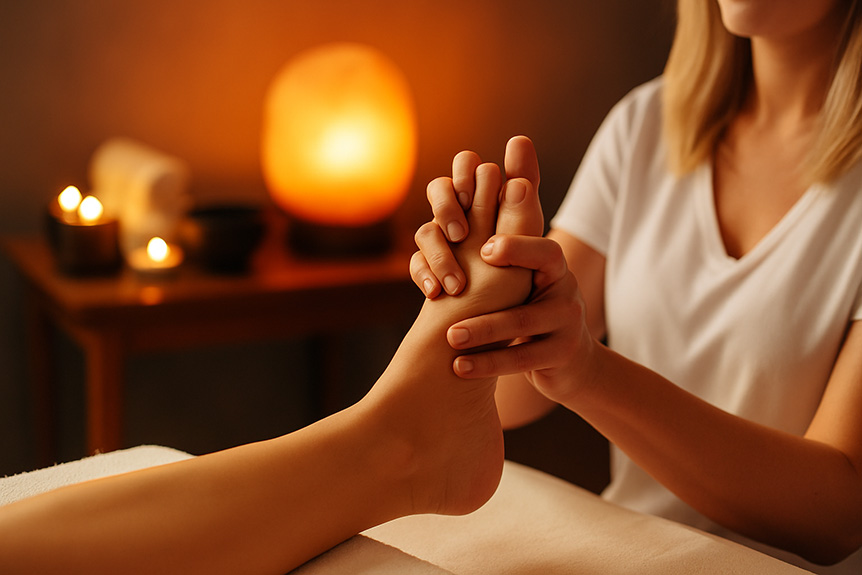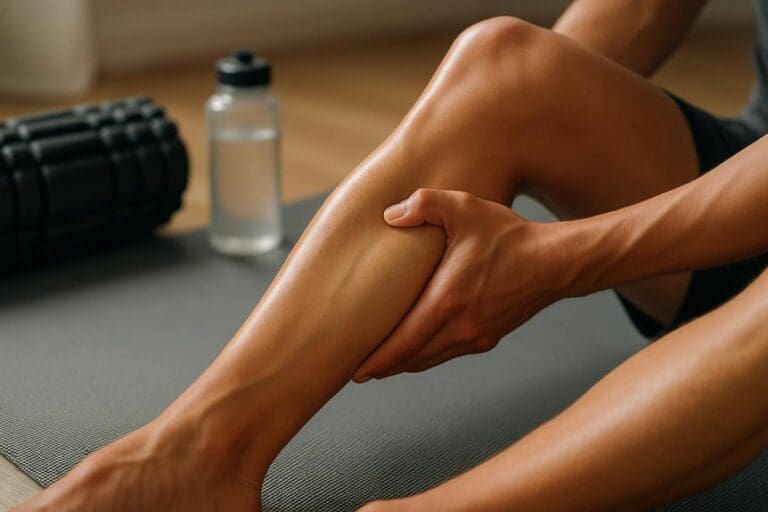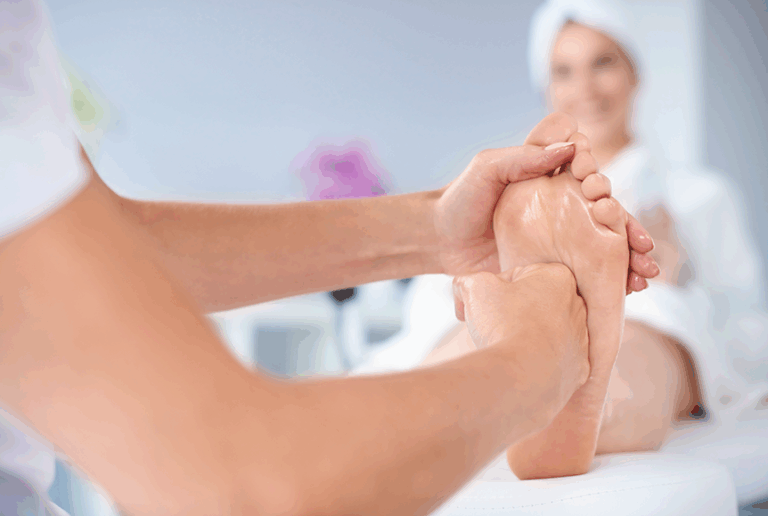This massage is a complementary therapy based on the principle that specific reflex points on the feet, hands, and ears correspond to different organs and body systems. Through targeted pressure and precision techniques, practitioners stimulate these reflex zones to promote physiological balance, enhance circulation, and encourage relaxation. Clinical evidence indicates that this massage therapy may help modulate the autonomic nervous system and support homeostasis. For those interested, further information details how this massage is applied and the benefits it offers for holistic wellbeing.
The Origins and Principles of this Massage
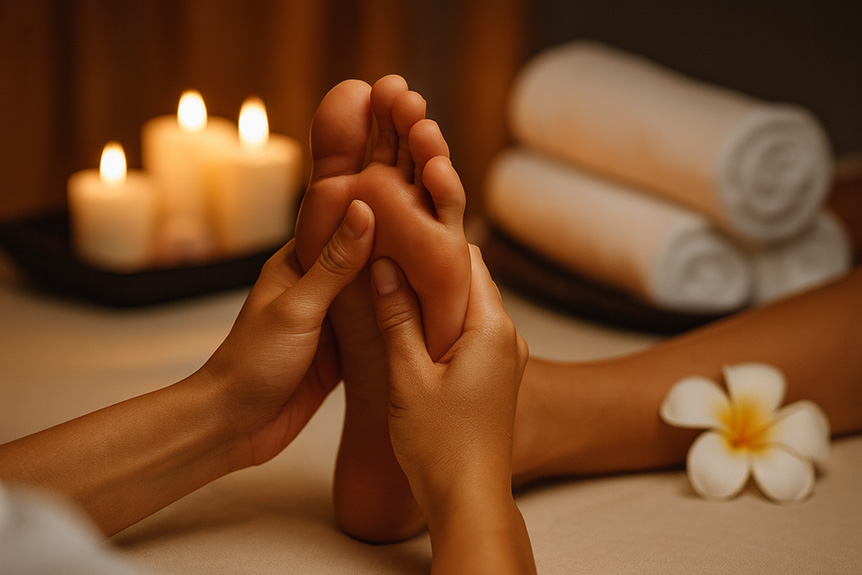
It is a complementary therapy rooted in ancient practices, with historical evidence tracing its origins to early Egyptian, Chinese, and Indian civilizations. This therapeutic modality is based on the principle that specific areas of the feet, hands, and ears correspond to various organs, glands, and systems throughout the body. Practitioners apply targeted pressure to these reflex points, aiming to promote physiological homeostasis and support the body’s natural healing processes.
The underlying concept is that stimulating these mapped zones can facilitate improved circulation, stress reduction, and overall well-being. At Spa & Massage, the application of reflexology reflects both respect for its historical foundations and adherence to modern clinical standards, ensuring that each session is carefully tailored to individual needs for the most effective therapeutic benefit. Many people discover the healing power of zone therapy when seeking an effective, natural approach to enhance their general wellness and reduce tension.
How It Works: The Science and Art
It is based on the stimulation of specific reflex points and zones on the feet, hands, or ears, which correspond anatomically to organs and systems throughout the body.
Clinical studies suggest that targeted pressure on these areas may activate nerve pathways, promoting physiological responses such as improved circulation and relaxation.
This process is intended to support the body’s intrinsic mechanisms for restoring balance and homeostasis, which is a principle emphasized in the treatments provided at Spa & Massage clinics.
Reflex Points and Zones
How does stimulation of specific areas on the feet or hands influence overall well-being?
It is based on the concept that distinct reflex points and zones correspond anatomically to organs, glands, and structures throughout the body. Practitioners, such as those at Spa & Massage, employ targeted pressure techniques to these mapped zones—most commonly on the soles, arches, and toes—believing this interaction promotes systemic balance.
Clinical models describe ten longitudinal zones extending from the toes to the head, with cross-sectional lines marking key reflex areas. Through methodical palpation, therapists aim to facilitate physiological relaxation, modulate stress responses, and encourage homeostasis.
This precision-driven approach reflects Spa & Massage’s commitment to evidence-based practice, ensuring each session is tailored to individual needs, fostering a sense of comfort and holistic well-being.
Nerve Pathways Activation
Numerous neurophysiological mechanisms underpin the therapeutic effects observed in this therapy. Specific pressure applied to reflex points on the feet, hands, or ears is believed to stimulate afferent nerve fibers. This stimulation conveys signals through peripheral nerve pathways to the spinal cord and central nervous system, facilitating a cascade of neurochemical responses.
Evidence suggests these interactions may modulate pain perception, encourage endorphin release, and promote a state of relaxation. In Spa & Massage clinics, therapists employ precise techniques to target these nerve endings, aiming to support the client’s overall well-being.
Through intentional touch, clients often experience sensations that extend beyond the initial area of contact, reflecting the intricate connectivity of the nervous system and the body’s capacity for self-regulation through gentle neural activation.
Body Balance Mechanisms
While the precise mechanisms remain under active investigation, current research indicates that targeted stimulation of reflex zones may contribute to restoring homeostatic balance within the body.
It is thought to modulate autonomic nervous system activity, potentially reducing sympathetic dominance and enhancing parasympathetic responses. This shift supports physiological processes such as improved circulation, regulated glandular function, and efficient waste elimination.
At Spa & Massage, therapists apply refined pressure to specific foot, hand, or ear points, encouraging the body’s intrinsic regulatory mechanisms.
The interplay between nociceptor activation and neurotransmitter release may further facilitate systemic equilibrium.
Clients frequently report a sense of deep relaxation, improved energy flow, and enhanced well-being, aligning with scientific observations of stress reduction and functional balance following massage sessions in clinical settings.
Key Benefits of This Massage for Wellbeing
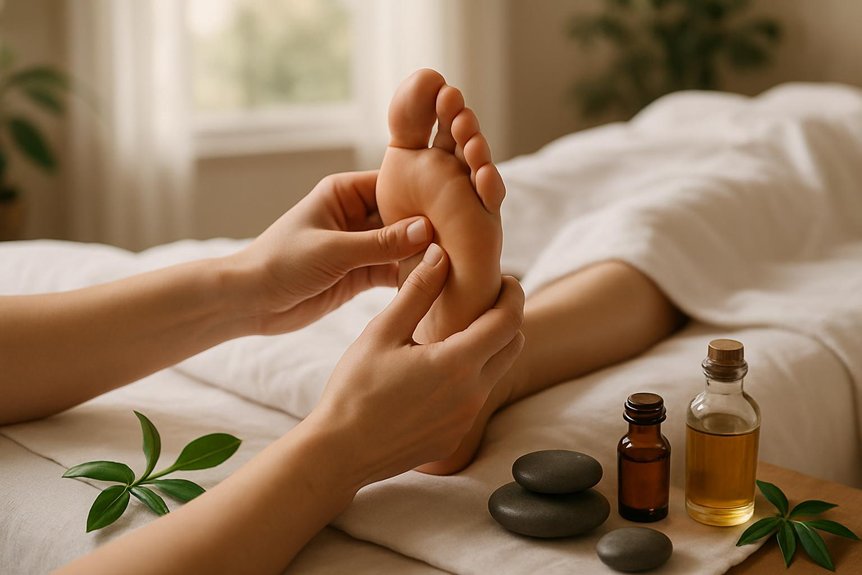
Clinical evidence indicates that zone therapy may contribute to enhanced stress relief, improved peripheral circulation, and greater holistic body balance.
At Spa & Massage clinics, therapists utilise targeted pressure techniques shown to activate the parasympathetic nervous system and promote homeostasis.
These benefits are frequently observed among clients seeking complementary approaches to overall wellbeing.
Enhanced Stress Relief
How does this massage facilitate stress reduction at a physiological level? It is understood to modulate the autonomic nervous system by stimulating specific pressure points, promoting a shift from sympathetic dominance (fight-or-flight) to parasympathetic activity (rest-and-digest).
This recalibration can decrease cortisol secretion, lower heart rate, and induce muscular relaxation. At Spa & Massage clinics, therapists apply targeted pressure to reflex zones, eliciting a measurable relaxation response.
Clients often report a profound sense of calm following sessions, which aligns with evidence suggesting reduced physiological arousal and enhanced mood.
The technique’s ability to alleviate tension appears rooted in neuroendocrine pathways, which mediate the body’s stress response.
This massage therapy, when integrated into a well-being regimen, offers an approachable, non-pharmacological method for managing everyday stressors in a restorative manner.
Improved Circulation Flow
Beyond its role in modulating the stress response, massage exerts a significant influence on peripheral circulation. By applying systematic pressure to specific reflex zones, practitioners stimulate vasodilation and enhance microvascular blood flow.
This improved circulation facilitates more efficient oxygen and nutrient delivery to tissues, while supporting the removal of metabolic waste products.
Clinical observations at Spa & Massage indicate that many clients experience a notable reduction in sensations of cold extremities and peripheral discomfort following massage sessions.
The technique’s targeted stimulation of foot and hand reflex points is believed to activate neurovascular mechanisms, which may promote ideal tissue perfusion.
As part of a thorough wellness programme, this type of therapy can play a pivotal role in supporting vascular health and fostering comfort, especially for those seeking therapeutic touch in a soothing environment.
Holistic Body Balance
A considerable body of evidence suggests that this massage contributes to holistic body balance by modulating autonomic nervous system activity and supporting homeostatic regulation.
By applying targeted pressure to specific reflex points, this technique is theorised to activate neural pathways that influence physiological systems throughout the body.
Clinical observations indicate that zone therapy may facilitate equilibrium between sympathetic and parasympathetic responses, encouraging a state of systemic harmony.
At Spa & Massage, therapists employ evidence-based to this massage protocols to address individual patterns of imbalance, prioritising client-centred care.
The practice is commonly associated with reduced stress, improved sleep quality, and enhanced emotional resilience—outcomes that reflect whole-person wellbeing.
Clients frequently report an increased sense of grounding and internal coherence, supporting the view that this massage is a valuable modality for nurturing holistic health.
What to Expect During a Session
During a session at Spa & Massage, clients are typically positioned in a comfortable reclined chair or massage table. Only their shoes and socks are removed to allow direct access to the feet. The therapist conducts a brief assessment, discussing individual health history and wellness goals.
Using precise thumb and finger techniques, the practitioner applies targeted pressure to specific reflex points mapped on the feet, which correlate with anatomical systems throughout the body. The environment is designed for tranquility, often accompanied by soothing ambient music and soft lighting to enhance relaxation.
Sessions generally last 30 to 60 minutes. Clients may experience localized sensations or a gentle, systemic sense of release, reflecting the activation of neural pathways. Hydration is encouraged post-session to support circulatory and lymphatic responses.
Common Conditions Addressed

Many clients attending Spa & Massage clinics seek zone therapy as a non-invasive adjunct to manage specific health concerns. Frequently reported conditions addressed through reflex point treatmentinclude stress-related disorders, tension headaches, migraines, and musculoskeletal discomfort such as plantar fasciitis or lower back pain.
This massage is also utilised to support circulation, ease symptoms of chronic fatigue, and alleviate digestive disturbances including irritable bowel syndrome. Some clients present with sleep disturbances or mild anxiety, seeking the calming neuromodulatory effects attributed to this modality.
Additionally, this massage may be considered as part of integrative care for clients experiencing hormonal fluctuations or menstrual discomfort. While clinical research continues to investigate mechanisms and efficacy, this massage remains a popular complementary approach at Spa & Massage clinics, tailored to individual wellness goals in a nurturing environment.
Massage Techniques Used at Spa & Massage
With a focus on precision and individualised care, therapists at Spa & Massage employ a thorough range of massage techniques designed to address specific zones and pressure points on the feet, hands, or ears. Techniques include thumb walking, finger pressure, and rotational movements, each calibrated to stimulate targeted reflex points corresponding to internal organs and systems.
The application of gentle yet firm pressure, combined with systematic sequencing, aims to optimise neural pathways and promote homeostasis. Detailed mapping guides the practitioner, ensuring that each session is tailored to the client’s unique needs.
The clinical intention is to facilitate improved circulation, support autonomic nervous system balance, and encourage physiological relaxation. Every technique is delivered with mindful attention, fostering both therapeutic efficacy and a sense of connectedness.
Aftercare and Tips for Maximising Results
Following a massage session, implementation of structured aftercare is essential to optimise therapeutic outcomes and sustain physiological benefits.
Immediate post-session recommendations at Spa & Massage include adequate hydration to facilitate metabolic waste elimination and gentle mobilization to support microcirculatory enhancement.
Clients are advised to avoid strenuous activity and stimulants for several hours, allowing the parasympathetic nervous system to consolidate relaxation responses.
Incorporating mindfulness or deep breathing augments neuromuscular integration and prolongs the sense of calm.
Application of soothing emollients, as used in Spa & Massage clinics, can further nourish the skin and promote tactile comfort.
Regular massage sessions, tailored to individual health goals, strengthen cumulative effects.
Adhering to these aftercare protocols amplifies symptom relief and fosters sustained wellbeing, underscoring Spa & Massage’s holistic approach to client care.
Conclusion
This therapy represents a remarkable fusion of tradition and technique, targeting tension and triggering therapeutic transformation. By precisely pressing predetermined points, practitioners promote physiological balance, potentiate natural healing, and provide profound relaxation. Scientific studies support its subtle, supportive role in stress reduction and symptom alleviation. At Spa & Massage, skilled specialists synergise expertise and empathy, ensuring each session is both safe and soothing. This remains a respected resource for restoring resilience, relaxation, and robust wellbeing within a clinical context.
